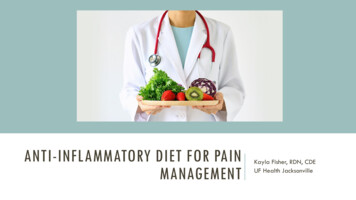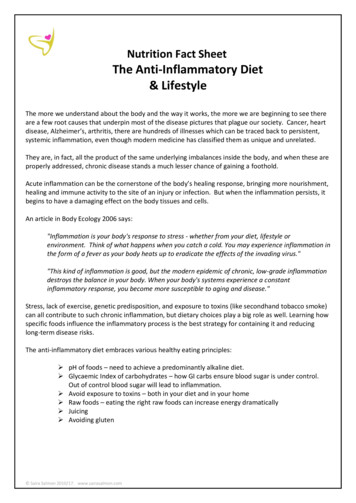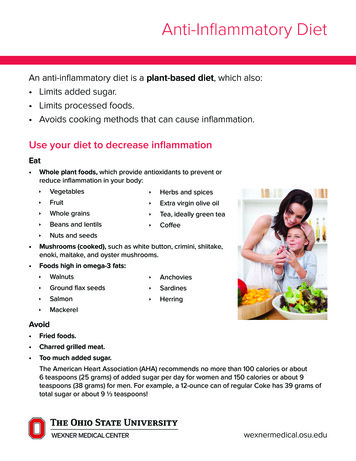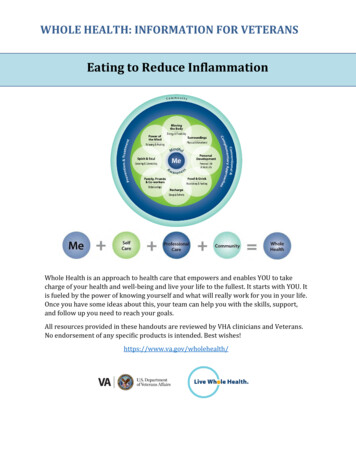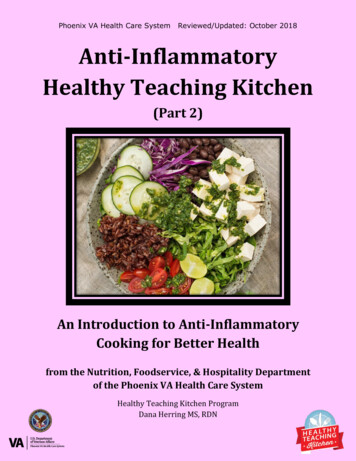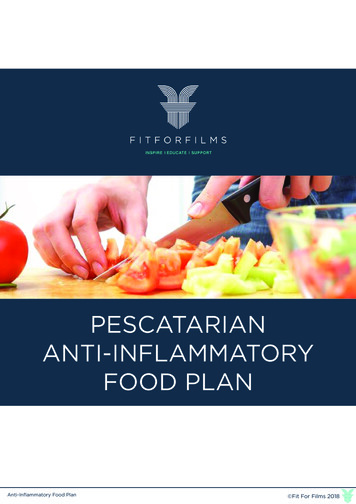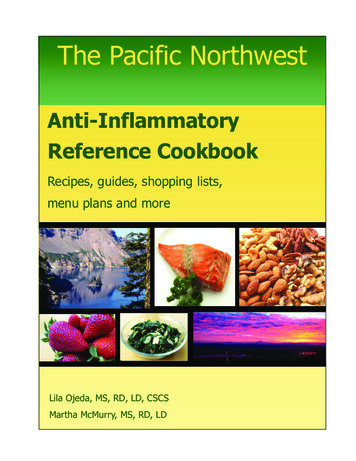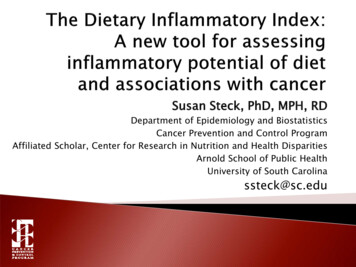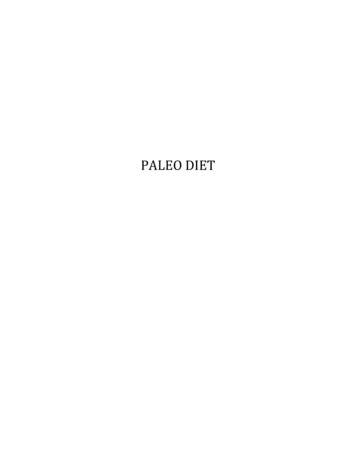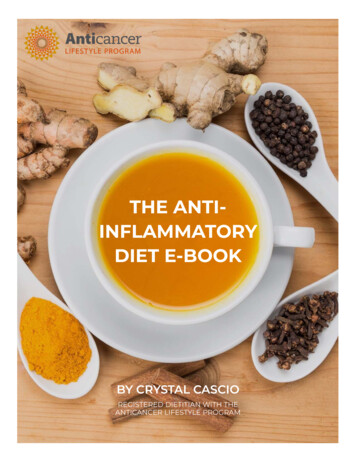
Transcription
THE ANTIINFLAMMATORYDIET E-BOOKBY CRYSTAL CASCIOREGISTERED DIETITIAN WITH THEANTICANCER LIFESTYLE PROGRAM
ABOUT CRYSTALCrystal is a Registered Dietitian (RD)with the Anticancer LifestyleProgram. She is also a yoga teacherand health coach who is passionateabout Anticancer living. Aftergraduating with her B.S. degree innutrition from the University of NewHampshire, Crystal went on to pursueher M.S. degree in nutrition from NewYork University.Crystal believes in the importance oflooking at all aspects of lifestyle, andtaking a personalized, holisticapproach toward optimal health andwell-being. She coaches in the ACLPmodule areas of Diet, Fitness, andMindset. In her free time, Crystalenjoys trying new recipes, visitingfarms, shopping at farmers markets,doing yoga, being outdoors, traveling,reading and most importantly: livingan Anticancer lifestyle!
IN THIS E-BOOK, YOUWILL LEARN ABOUT: Inflammation and its role inchronic disease Foods that may raise or lowerinflammation Which herbs and spices canreduce inflammation Other lifestyle habits that canhelp control inflammation(Please note that some individuals mayexperience inflammation whenconsuming particular foods, such asgluten-containing grains. The purposeof this e-Book is to summarize thescientific literature related to generalanti-inflammatory eating. If you havepersonal food allergies, intolerances,and/or sensitivities, be sure to workindividually with a qualified RegisteredDietitian Nutritionist.)
THERE ARE TWO TYPESOF INFLAMMATION:ACUTE AND CHRONICACUTE inflammation is one of themany responses of the immunesystem used to defend the bodyfrom injury. Common symptomsinclude redness, heat, pain, andswelling due to inflammatorychemicals being released into thebloodstream traveling to the site ofinjury. This response is inherentlyprotective. It helps to eliminateharmful substances and healdamaged tissue. It is essential forhealing wounds and combatinginfection.CHRONIC inflammation occurswhen the inflammatory responsefails to resolve, and/or when harmful,poisonous, or unpleasant stimulipersist in the body. Chronicinflammation, sometimes referred to“silent” inflammation, is oftenpainless, but as Inflammatorychemicals are continually releasedinto the bloodstream, over time theycan damage our organs and tissues,and eventually may increase risk forchronic diseases, such as diabetes,cancer (especially colorectal cancer),coronary artery disease, stroke,cardiovascular disease, rheumatoidarthritis, metabolic syndrome andasthma.Acute inflammation is short-term,temporary, and self-limiting. Ablood test, called C-Reactive Protein,can be taken to determine if acuteinflammation is present; however, itis not a reliable diagnostic for chronicinflammation. Blood tests forThink of chronic inflammation asinflammation are a clue, but shouldputting your body into a constantonly be thought of as one piece ofstate of alert. It can be caused bythe entire inflammation puzzle.auto-immune disorders, long-termexposure to irritants (such aspollution and toxic chemicals), and arange of other lifestyle factors, suchas dietary factors, smoking, alcoholconsumption, and chronic stress.
OBESITY AND INFLAMMATIONResearch shows that obesity is associated withinflammation. Fat cells may increase inflammation inthe body by producing and releasing inflammatorychemicals (such as cytokines). Fat cells also have thepotential to increase the amount of circulatinghormones, such as estrogen. According to the Centersfor Disease Control (CDC), It is estimated that 40% ofadult cancers are correlated with overweight andobesity alone. Note that this does not meaninflammation or body weight caused these cancers andother disorders, only that they are linked in ways wehave yet to fully understand.It is important to emphasize that many factors play arole in someone’s weight including - but not limited to the following: genetics, medications, medicalconditions, socioeconomic factors, diet, exercise, weightstigma, racism, race or ethnicity, weight cycling, trauma,sex, history of dieting, certain medical conditions,increased stress, and not enough sleep. Try to focus onmodifying behaviors that you can control - such ashow you manage stress, how much you sleep andmove, and what you eat - versus focusing on somenumber on the scale. Research supports that engagingin health-promoting behaviors can positively impact ourhealth and disease risk regardless of changes in weight.
WHAT EXACTLY IS ANANTI-INFLAMMATORY DIET?Inflammation is a process that is strongly influencedby lifestyle factors such as one’s diet. (In this context,the word “diet” refers to the kind of food a personhabitually eats.) Inflammatory diets have beenlinked to numerous cancers, including colorectal,breast, head and neck, gynecological, prostate,esophageal, and others.While there is no single definition of an antiinflammatory diet, these diets differ markedly whencompared to the Standard American Diet (which hasthe appropriate acronym of SAD), which is high inred meat, sugar, refined or processed carbohydrates,and lower in fish, fruit and vegetable consumption.
The diets most commonly considered as antiinflammatory incorporate aspects of the Mediterraneanand Okinawan diets.The Mediterranean diet is high in fruits, vegetables,fish, olive oil and moderate red wine intake. TheOkinawan diet is high in vegetables and fruits, and lowin dairy and red meat. This diet is lower in fat intakethan the Mediterranean diet. Anti-inflammatory dietsare rich in Vitamins C and E, other antioxidants,fiber, flavonoids, magnesium, carotenoids, omega 3fatty acids, polyunsaturated fatty acids,monounsaturated fatty acids, zinc and probiotics.This can be contrasted with the typical Western diet,which is associated with inflammation. This diet istypically high in protein (particularly animal proteins),fried foods, sugar, and refined carbohydrates. It is lowin fiber, fruits, vegetables, and associated nutrients.High iron diets have also been linked to inflammation.
AN ANTI-INFLAMMATORYPLATE MIGHT INCLUDE:ASIANMUSHROOMSPLANT-BASED PROTEINSOR FATTY FISHFRUITSWHOLEGRAINSWATEROR TEASHEALTHYFATSNON-STARCHYVEGETABLESUTILIZE HERBSAND SPICES
CARBOHYDRATESAND INFLAMMATIONExcessive consumption of refined carbohydratescan increase inflammation. Examples include: Sugary foods such as sweets White bread Bagels White pasta White rice Sugary beveragesRefined carbohydrates are highly processed andstripped of many nutrients. Excess consumption ofrefined carbohydrates can cause hyperglycemia(high levels of sugar in the blood). Chronichyperglycemia can lead to increased production offree radicals and pro-inflammatory cytokines, therelease of inflammatory chemicals, and greaterinsulin production, which in turn can cause a spike inIGF-1 (insulin-like growth factor 1). High levels of IGF-1are associated with increased risk of a number ofcommon cancers, including lung, breast, colorectal,and prostate. In other words, excess consumption ofrefined carbohydrates can lead to a hazardouscascade of health problems.Instead of refined sugars, choose whole grains,which have all their original parts present (bran,germ and endosperm). Examples of whole grainsinclude buckwheat, barley, rye and wild rice.
BUCKWHEATSTEEL CUT OATSFARROWILD RICEThese whole grains are also high in fiber which hasbeen shown to reduce inflammatory markers.Choose whole grain bread over white or refinedbread. When reading nutrition labels, look for theword “whole” in the ingredient list and avoid“enriched” grain products.
FATS ANDINFLAMMATIONOmega-3 fats may lower inflammation. Sources ofomega-3 fats include: Fresh water fatty fish (such as salmon, sardines,mackerel, halibut, herring and anchovies) Chia seeds Flaxseeds (ground) Walnuts Hemp seeds Seaweed
OMEGA-6Reduce your intake ofomega-6 fats. Sources ofomega-6 fats include: Safflower oilSunflower oilCorn oilSoybean oilVegetable oil
Aim to use other oils such as olive oil (preferablyextra virgin olive oil) and avocado oil more often thanvegetable oils. While olive oil can be used for lowerheat cooking, it is best to use avocado oil for higherheat cooking.When choosing fish, wild-caught fish is preferableto farm-raised fish. Fish in the wild eat a natural dietwhile farmed fish eat a diet that is usually made up ofdried pellets that contain soy and/or corn.Farmraised fish may also be higher in contaminants andhave a higher incidence of disease due to farmingconditions. Wild-caught tends to have higher levels ofomega-3 fatty acids, particularly fresh water fatty fishsuch as salmon, lake trout, mackerel and sardines.Remember that the nutrition quality of the seafooddepends on what the fish eats — or as author MichaelPollan puts it, “You are what what you eat eats.”Consider using the Environmental Working Group's(EWG) Good Seafood Guide, or the Monterey BayAquarium’s Seafood Watch Guide to purchase saferseafood.
FATS FROM NUTSConsumption of nuts has been linked to lower inflammatory markers,which may result from high omega-3 fats in nuts such as walnuts.FATS TO AVOIDFats to avoid include soybean, cottonseed, peanut and corn oils as theyare pro-inflammatory. Trans fats should also be avoided as they have astrong effect on inflammation. Sources of trans fats include products with“partially hydrogenated oils” in the ingredient lists (such as baked goods) andthey’re found in small amounts in meat and dairy products from ruminantanimals (cattle, sheep and goats).
POLYPHENOLSPolyphenols are a large class of plant-based compounds thatare important for human health. They are powerful antioxidants withanti-inflammatory effects capable of preventing or reversing cellulardamage, activating the immune system, promoting good gut bacteria,and reducing cancer risk. It’s best to consume polyphenols throughfoods naturally containing them, rather than as supplements.Foods high in polyphenols include herbs, spices, cocoa, berries(especially dark in color), flaxseeds, chestnuts, hazelnut, olives, capers,pecans, sweet cherries, apple, spinach, shallot, almonds, red onion,elderberry, capers, prunes, almonds, and more.Herbs and spices high in polyphenols include cloves, driedpeppermint, star anise, dried oregano, celery seed, dried rosemary, driedthyme, curry powder, dried ginger, fresh thyme, dried lemon verbena,and more.
FRUITS AND VEGETABLESDiets high in fruits and vegetables correlate with lower inflammatorymarkers in the blood. They contain vitamins, minerals andphytonutrients including polyphenols. Aim for a variety of colors andtypes and choose organic or homegrown when possible due to lowerlevels of pesticides and more antioxidants. Seasonal produce isrecommended because it yields more available nutrients and antioxidantproperties and often at a cheaper cost.Choose frozen when eating out of season as many fruits andvegetables retain and even enhance nutrients when frozen, providing agood alternative when eaten out of season. Frozen fruits and vegetablesare usually picked at peak ripeness and then blanched and frozenimmediately.
CALORIC INTAKEEating more than your bodyneeds or over-consuming foodcan increase inflammation.Exact reasons why are unknownat this time. Possible mechanismsinclude increased consumption ofinflammatory foods when oneovereats, stress on digestive tract,etc. It is important to learn topractice honoring your fullnesslevels. (For more on this, pleasesee the ACLP website formy webinar and ebook, bothtitled “Food and You: GainingControl Over Out- of- ControlEating.”)
PROTEIN SOURCESProtein consumed should be primarily plant-basedwith, if desired, some sources of fish and smallamounts of lean meats. Aim for more plant-basedsources of protein as animal proteins contain moreinflammatory omega-6 fatty acids. The type of fat in theprotein source determines its inflammatory potential.Animal meats contain cholesterol which is present inmeat, eggs, and fish and promotes inflammation throughaccumulation in immune cells and via othermechanisms. Saturated fatty acids (found mainlyanimal foods) may promote inflammation throughvarious mechanisms, including activating certain genesthat have been associated with increased inflammation.
Soy contains phytonutrients, protein and healthy fats that contribute toits anti-inflammatory properties. Soy has been found to decrease theinflammatory markers interleukin 6, TNF-alpha and CRP. Phytoestrogens insoy contribute to soy’s ability to reduce systemic inflammation. Whole soybased foods include edamame, tempeh, miso, tofu and soy milk. If soyyogurt is consumed, choose soy yogurt made with soy milk from wholesoybeans, which is indicated if the ingredient list is limited to filtered waterand soybeans and excludes added sugars and fillers.Enjoy legumes including beans, lentils, peanuts and peas as healthfulprotein sources. Mushrooms are another good option as they havepolyphenols, anti-inflammatory phytonutrients and protein. Be sure to cookthem and avoid eating them raw, for a couple of reasons: first, mushroomscontain traces of carcinogenic compounds that are destroyed by heat.Second, since mushrooms have a tough cellular structure that is softened byheat, cooking releases more of their nutrients.
ANIMAL MEATSChoose animal meats from animals that have been raised the waynature intended, with access to the outdoors. Grass-fed beef has ahigher amount of benef icial omega-3 fats when compared toconventional beef. Organically produced meats and dairy have beenshown to have higher levels of omega-3 fats when compared toconventional counterparts.Cook animal meats at low temperatures as high temperatures producemore pro-inflammatory chemicals such as heterocyclic amines (HCAs)and polycyclic aromatic hydrocarbons. These have been shown to causecancer in animal models. Though a direct link to cancer in humans has notbeen established, epidemiological studies (meaning studies of largepopulations) have found strong associations between increasedconsumption of meat cooked well-done or grilled, and cancer.
Marinating meat prior to cooking can reduce heterocyclic amines(HCAs), so consider marinating, mixing or rubbing meat with any of thefollowing prior to cooking: olive oil, cider vinegar, garlic, mustard, lemonjuice, salt, herb and spice rubs, homemade sauces, onions or red wine.Removing skin before cooking chicken reduces HCA productionsignificantly.The jury is still out on eggs. Eggscomes to inflammation. However,impact of eggs on chronic diseases,patients specifically should limit oreggs, choose organic or free range.are likely a “neutral” food when itcontroversy exists regarding theincluding cancer. Prostate canceravoid consumption. If consuming
OTHER THINGSTO CONSIDERConsuming green tea, black tea,rooibos tea, red wine, blueberries,blackberries, red grapes, kiwi,watermelon, parsley, spinach, andcruciferous veggies can all inhibitmutagenic activity (meaningchange in the cell’s DNA) of certainHCAs. The bacteria found infermented dairy foods also havethis effect. Thus, incorporating anyof these foods into mealscontaining barbecued meat orpoultry may lessen the mutageniceffect.Drinking tea can have an antii n fl a m m a t o r y b e n e fi t . Te acontains antioxidants andpolyphenols. Green, black andwhite teas contain the highesta m o u n t s o f t h e s e b e n efi c i a lcompounds. Be mindful of whereyou are sourcing your tea from —ideally, choose organic. Herbalteas can also have antioxidant andanti-inflammatory benefits.
ALCOHOL IS AKNOWN CARCINOGENModerate intake of alcohol —considered to be one drink perday for women and two drinksper day for men — is acomponent of both theMediterranean and Okinawandiets.However, heavy drinking isassociated with increased levelsof C-Reactive Protein, a measureof inflammation. The importanceof moderation needs to beemphasized. Alcohol is a knowncarcinogen. No amount ofalcohol is considered safe forcancer.
HERBSAND SPICESWhen it comes to herbs andspices, the more the better, soinclude them as often as possible!Ginger and turmeric are the twoherbs with the largest amount ofdata supporting their impact oninflammation. They are known toinhibit pro-inflammatorycytokines including IL-2, TNFalpha, IL-8 and other proinflammatory compounds. Pairturmeric with black pepper anda fat for maximum absorption.Garlic, cayenne and oreganoalso have anti-inflammatoryproperties.
OTHER LIFESTYLE FACTORSTHAT IMPACT INFLAMMATIONConsider how you consume food. Do you eat fast, or when distracted? Eatingslowly, mindfully and honoring fullness (versus overeating) can decrease theimpact of inflammation on the body.Other lifestyle factors that impact inflammation include: increased stress,sleep disruption, exposure to toxins, lack of connection to the natural worldand other beings, lack of physical activity and tobacco use.Always remember that studies have found that the overall composition ofyour diet is more important for predicting the risk of chronic disease andmortality than specific nutrients. For example, consuming a form ofsaturated fat in a recipe that is high in fruits and vegetables and other plantbased foods is not going to cause inflammation. It is more important to look atthe overall quality of your diet.
ANTI-INFLAMMATORY FOODS: A REVIEW
EAT LESSConsider Avoiding:Sugar-sweetened beverages (sodas, juices, sweetened teas, energy drinks,etc.)Processed meats (bacon, salami, bologna, pastrami, spam, etc.)Products that contain hydrogenated oils (trans fats) in the ingredient lists(such as baked goods made with hydrogenated oils)Oils high in omega-6 fats such as: Vegetable oil, corn oil, soybean oil,cottonseed oil, peanut oil, etc.Fried foods (such as fried chicken, fried vegetables, etc.)Conventionally produced animal products such as eggs, poultry, beef,pork, lamb, etc.Farm-raised fishConsider Limiting:Animal products (whether conventional or organic), especially red meats,including beef, pork, and lamb.Refined carbohydrates (white pasta, white rice, white bread, crackersmade with white flour, sweets, etc.)Sugars and syrups (all forms including honey, maple syrup, agave, canesugar, coconut sugar, etc.)Processed foods, including fast foodsMeats cooked at very high temperatures (such as grilled or broiledmeats). Be sure to marinate, mix, or rub prior to cooking meat at hightemperatures with any of the following: olive oil, cider vinegar, red wine,garlic, mustard, lemon juice, herb and spice rubs, homemade sauces,onions. Also, consider removing the skin on poultry before cooking.A note on alcohol:Aim to avoid or drink less alcohol. Too much alcohol can raise inflammation,and alcohol is a known carcinogen (potential cancer-causing compound).
“LET FOOD BETHY MEDICINEAND MEDICINETHY FOOD.”- Hippocrates
To sign up for our free course, please visitthe Anticancer Lifestyle Program website.www.anticancerlifestyle.orgThe Anticancer Lifestyle Online Course is afree, expert-led program that helps youmake healthy and informed lifestylechoices to reduce your risk of cancer,cancer recurrence, and chronic illness. Ourself-paced course is filled with evidencebased tools, tips, and information topromote well-being in the areas of Diet,Fitness, Mindset, and Environment.
The Mediterranean diet is high in fruits, vegetables, fish, olive oil and moderate red wine intake. The Okinawan diet is high in vegetables and fruits, and low in dairy and red meat. This diet is lower in fat intake than the Mediterranean diet. Anti-inflammator
